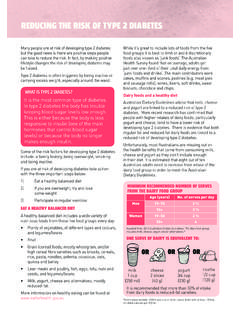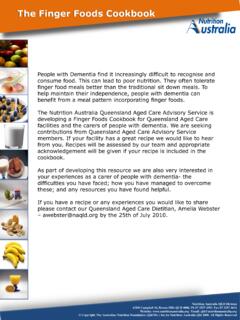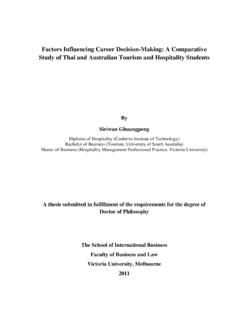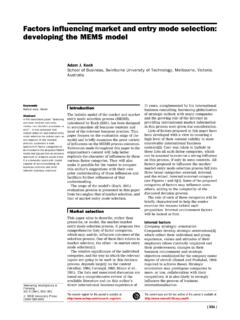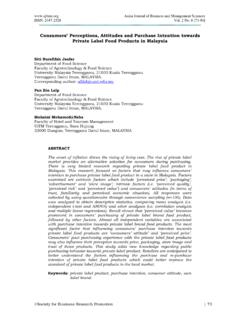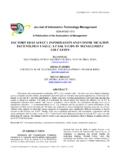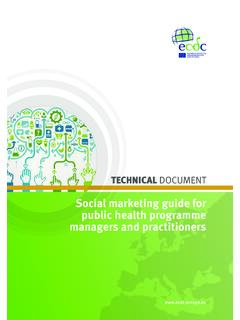Transcription of Diet and nutrition: A literature review of factors ...
1 Diet and nutrition : a literature review of factors influencing blue-collar apprentices1. Karin du Plessis, Incolink, Victoria A nutrient-rich diet could assist apprentices to maintain a healthy body and mind. The nature of most construction industry apprenticeships is such that it requires concentration and moderate to high levels of physical activity, and consequentially apprentices need a diet which can support these required high energy demands. Anecdotally, apprentices display a range of dietary practices, which appear to be moderated by their taste preferences, nutritional beliefs and knowledge, environment ( , availability of food; healthful dietary messages) and degree of prescription to traditional masculine stereotypes. The determinants of healthy eating, the effect of nutrition on mental health, gender differences in nutrition , and workplace programs are discussed in this literature review .
2 Although no studies which specifically focus on apprentices' diets have been identified, the literature will make inferences from related age groups and work environments. Due to this paucity of research, some researchers have specifically called for more focused nutrition interventions with young men (Walsh & Nelson 2010). Introduction Nutrients are consumed through the food that we eat, and through metabolic processes in the digestive system these nutrients are absorbed at a cellular level in the body (Gibney et al. 2009). Optimum nutrition contributes to health, wellbeing, normal development, and high quality of life (Gibney et al. 2009). However, undernutrition, overnutrition, and malnutrition are linked to sub- optimal health outcomes (Gibney et al. 2009). Such poor diets have been linked to the occurrence of chronic diseases, including cardiovascular disease, Type-2 diabetes, cancer, osteoporosis and anaemia (Lytle et al.)
3 2002). For example, research reports that low intake of fruit and vegetables increases the risk for developing cancer (Steinmetz & Potter 1996), as well as cardiovascular disease (Hung et al. 2004), whereas low intake of dietary fibre has been linked to being overweight (Patrick et al. 2004). Obesity is often a consequence of overnutrition, and it is an ever-increasing problem in both developing and food-secure countries, such as Australia (Gibney et al. 2009). A recent longitudinal study conducted in Victoria report on the significant increase of obesity from adolescence to adulthood (Patton et al. 2010). This study of 1520 adolescents tracked over a period of 10 years also highlights the decreased likelihood of overweight adolescents achieving a normal weight in adulthood (Patton et al. 2010).
4 Frequently linked with a greater proneness to Type-2 diabetes ( , Wang, Hoy & Si 2010), obesity severely affects health-related quality of life in a range of domains, including, physical, social and psychological (Mannucci et al. 2010). However, factors influencing 1. First published as a chapter in Corney, T., & Du Plessis, K. (Eds.) (2011). Apprentices young people in transition, Melbourne: Incolink & Australian Clearinghouse for Youth Studies, and reproduced with permission. 1. obesity and chronic diseases are more complex than diet alone. For example, together with increased sedentary behaviour, decreased physical activity has been shown to play a crucial role in becoming overweight and obese (Patrick et al. 2004). For the purposes of this project, and literature review , the focus will be on the diet and nutrition of apprentices, although the influence of other factors ( , lifestyle and environmental factors ) is acknowledged, but noted as outside the scope of this project.
5 Determinants of healthy eating Individuals' reasons for buying and eating particular foods have been described as a complex bio- psychosocial process that is relative to person, place and time (Walsh & Nelson 2010, p. 194). Most researchers believe that dietary habits and food preferences develop in childhood, are established by age 15, and become habitual in due course (Birch 1999; Sweeting & Anderson 1994). Adolescence is thus still a key formative period in the development of eating habits (Walsh & Nelson 2010). Of interest is that some studies have identified a negative shift in the recommended nutrient consumption during adolescence, with reports that few adolescents are meeting recommend dietary guidelines (Patrick et al. 2004). For example, Lytle and colleagues (2002) conducted a large-scale longitudinal study of youth between the ages of 8 and 14, and found that their diets became less nutrient-dense over time.
6 In particular, this study found that during adolescence young people's diets showed an increase in fat, saturated fat and sodium, and a decrease in vitamins, minerals and fibre these nutrients are all those implicated in chronic disease (Lytle et al. 2002). Adolescents have also been found to consume less than adequate amounts of fruits and vegetables. A large-scale study of 16,262 youth (with a mean age of 16 years) identified that only 22% of young women and 29% of young men consumed the recommended daily fruit and vegetable serves (Pesa & Turner 2001). Construction industry apprentices (most often young men aged 16-24 years) could be considered vulnerable' due to the number of transitional issues and changes they face as they move from school to work. These changes include: Changes to their physical environment ( , moving out of the parental home; cohabiting with friends or a romantic partner), changes to their peer group (as new employees on a worksite, fellow-apprentices, new friends), changes in financial responsibilities ( , paying rent, purchasing a vehicle, purchasing food, paying bills), and educational/work responsibilities ( , successfully completing apprenticeship, performing successfully at work).
7 Lytle and colleagues (2002) argue that the transition to adolescence, where young people experience an increased need for autonomy and a desire to express themselves, influences young people's food choices. Furthermore, youth experience peer pressure which significantly influences their food choices (Lytle et al. 2002). In comparison to younger children, teens might also be exposed to more unhealthy food choices in their environment (Lytle et al. 2002). Apart from transitional issues there are also a number of collective factors which influences the decisions individuals make about food, which includes familial factors , food supply, and food acquisition ( , at home, work, markets, and through fast-food outlets) (Taylor, Evers & McKenna 2005). Recent research conducted with Irish adolescents (Walsh & Nelson 2010) indicates that parents are the biggest influencers in their children's diets.
8 In particular the frequency of shared dinners had a positive effect on adolescents' food knowledge (Walsh & Nelson 2010). Other factors influencing 2. adolescents' diets included their nutritional knowledge, friends (with whom high-fat fast foods were often consumed), government health campaigns and cooking programs on television (Walsh &. Nelson 2010). However, this study found that celebrity endorsements of food products had the least influence on adolescents' diets (Walsh & Nelson 2010). Other researchers note that the media, in particular television, promotes differential food marketing to youth (Lytle et al. 2002). A study by Wiecha and colleagues highlights the important role of television in shaping young people's intake of increased calorie-rich, low-nutrient food often advertised on television, and also explicitly links increased television viewing with increased calorie intake (Wiecha et al.)
9 2006). Food labelling and marketing of products also influence the choices that individuals make around food. For example, Jalleh and Donovan (2001) demonstrated that even though two products were identical, the positive framing of product attributes ( , 75% fat free) as opposed to negative framing ( , 25% fat content) influenced consumers' choice of purchasing the positively-framed product, as well as their positive perceptions of the product's taste and quality. Demographic factors , socio-economic status, as well as ethnicity, social, and cultural variables also influence food choices (Tepper, Choi & Nayga 1997). At the individual level numerous aspects such as hunger and satiety, food preferences, and attitudes and beliefs about food influence decisions around food (Tepper et al. 1997). Gracey and colleagues (1996) identified that 15-year old adolescent boys report the effects of a healthy diet to be an improvement in health', feeling energetic', feeling good about myself', lowering cholesterol' and improving appearance'.
10 These adolescent boys also identified some barriers to healthy eating, including healthy food not being available at home or in the school canteen, a lack of control over foods available at home, and a lack of nutritional knowledge ( , calorie content, sugar/fat content, fibre content) (Gracey et al. 1996). Nutritional knowledge has been indicated as a factor which influences food choice. However, some researchers question whether an increase in nutritional knowledge necessarily eventuates in improved food choices (Tepper et al. 1997), whilst other researchers have found that nutritional knowledge alone is insufficient to motivate healthy eating (Gracey et al. 1996). Although fewer men than women report that they have dieted' (Liebman et al. 2001), men's food choices have been found to be moderated by dietary restraint (defined as the conscious attempt by an individual to regulate body weight , Tepper et al.)




